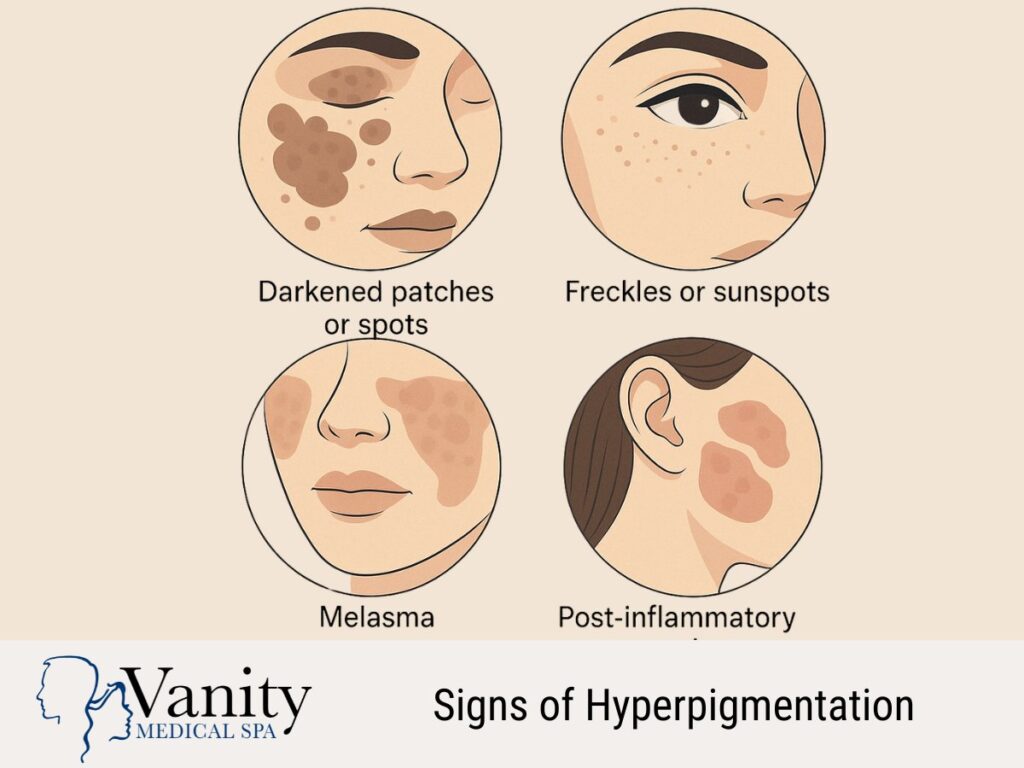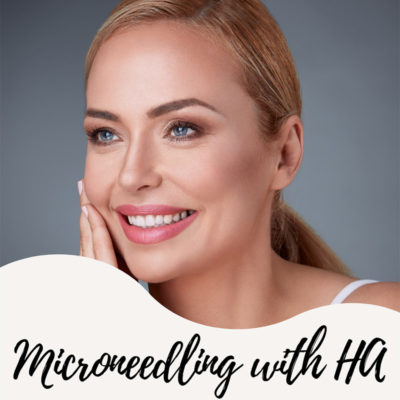Modern treatments for one of the most common—and treatable—skin concerns.
What is Hyperpigmentation?
Hyperpigmentation occurs when melanin—the pigment responsible for your skin color—is overproduced. This overproduction can be triggered by various factors, including:
Common Signs and Symptoms of Hyperpigmentation:
Darkened patches or spots on the skin
(brown, black, gray, red, or pink depending on the skin tone and type of pigmentation)Uneven skin tone
Freckles or sunspots becoming more prominent
Melasma (larger, blotchy patches often on the cheeks, forehead, or upper lip)
Post-inflammatory marks from acne, injuries, or rashes
Areas of discoloration that do not fade easily
Flat (not raised or textured) pigmented areas
More noticeable pigmentation after sun exposure

If you’re experiencing any of these signs, you’re not alone—and effective treatment is available. At Vanity Medical Spa in Paramus, NJ, Dr. Robert Berberian offers customized hyperpigmentation treatment plans tailored to your skin type and symptoms. Our goal is to reduce inflammation, improve skin clarity and texture, and restore your comfort and confidence.
Our Hyperpigmentation-Focused Treatments
While hyperpigmentation can be persistent, the right combination of treatments can dramatically reduce dark spots, melasma, and post-inflammatory discoloration—restoring clarity and confidence to your skin based on skin tone, pigment type, and budget.
 ✅ Chemical Peels: Ideal for sunspots, melasma, and acne-related pigmentation, our medical-grade chemical peels gently exfoliate pigmented skin cells and accelerate skin renewal. We offer a variety of peel strengths and formulas to match your needs and sensitivity level.
✅ Chemical Peels: Ideal for sunspots, melasma, and acne-related pigmentation, our medical-grade chemical peels gently exfoliate pigmented skin cells and accelerate skin renewal. We offer a variety of peel strengths and formulas to match your needs and sensitivity level.
✅ Exosome Therapy: These next-generation regenerative serums are packed with growth factors and signaling molecules that support skin repair, reduce inflammation, and help fade stubborn pigment. Perfect for post-inflammatory hyperpigmentation and dull, uneven skin tone.
✅ BBL Photofacial (BroadBand Light): BBL is one of the most effective treatments for sun damage and age spots. Using intense pulsed light (IPL), it targets melanin deep in the skin, breaking up pigmentation and encouraging a more even complexion with minimal downtime.
✅ Microlaser Peel: This light resurfacing laser gently removes the outermost layers of damaged skin, helping to lift pigmentation, smooth fine lines, and improve skin tone and texture. It’s a popular option for melasma and sun-related hyperpigmentation.
✅ Microneedling: Creates microchannels in the skin to stimulate collagen and allow customized brightening agents to penetrate more deeply. Effective for post-acne marks and stubborn dark spots.
✅ Morpheus8 Radiofrequency Microneedling: Combines the collagen-stimulating power of microneedling with radiofrequency energy to treat pigmentation at multiple skin depths. Especially effective for textured or hormonally driven pigmentation.
✅ Ozone Therapy : Ozone increases oxygen supply to skin tissues and promotes detoxification—helping to calm inflammation and support healing in pigmented or reactive skin. Great as a supportive therapy in combination with peels or lasers.
Not sure where to start?
We’ll guide you through a personalized plan during your consultation—based on your skin type, tone, and goals.
FAQ's about Hyperpigmentation
Hyperpigmentation, or darkening of the skin, is primarily caused by an overproduction of melanin, the pigment that gives skin its color. Several factors can trigger this increase in melanin production, including sun exposure, hormonal changes, and skin trauma or inflammation
Some of these triggers include:
- Exposure to sunlight
- Stress
- Hormonal fluctuations, such as during pregnancy
- Diabetes and Thyroid disease
- Exposure to heavy metals, such as iron, arsenic, gold, iron, and lead
- Tobacco smoke
- Alcohol and caffeine
- Genetics
The main types include:
- Melasma (hormone-related dark patches)
- Post-inflammatory hyperpigmentation (dark spots after injury or inflammation)
- Sunspots/liver spots (sun-induced dark spots)
- Freckles (small pigmented spots)
Not necessarily. With proper treatment and sun protection, many types of hyperpigmentation can fade significantly or disappear completely.
While not all cases of hyperpigmentation can be prevented—especially those related to hormones or genetics—you can greatly reduce your risk with consistent skincare habits. Simple steps like these can make a big difference:
Always wear sunscreen with SPF 30 or higher, even on cloudy days.
Choose skincare products that are gentle and suitable for your skin type.
Treat acne and other skin conditions early to avoid post-inflammatory marks.
Remove makeup thoroughly before bed to avoid irritation and clogged pores.
Prevention is about protecting and maintaining your skin’s barrier so it can heal properly without overproducing melanin.
In some cases, yes — mild forms of hyperpigmentation, such as post-acne marks or light sunspots, may fade over time with proper sun protection and skincare. However, deeper or hormonally driven pigmentation (like melasma) is less likely to resolve without targeted treatment.
Professional treatments such as peels, lasers, and topical brighteners can speed up the process and improve overall skin clarity more effectively than waiting it out.
Several everyday factors can worsen hyperpigmentation or make it harder to fade. These include:
☀️ Sun exposure – UV rays trigger melanin production, darkening existing spots and creating new ones.
🔥 Picking or irritating the skin – Scratching, squeezing pimples, or over-exfoliating can lead to post-inflammatory marks.
💄 Harsh skincare products – Ingredients that irritate your skin can inflame and worsen discoloration.
💊 Hormonal changes – Pregnancy, birth control, or hormonal imbalances can intensify conditions like melasma.
🌡️ Heat exposure – Heat from saunas, steam, or workouts can trigger melanin production in sensitive skin.
Wearing sunscreen daily and avoiding aggressive skincare habits can help prevent flare-ups and support fading.
Yes—with the right approach. At Vanity Medical Spa, we understand that treating hyperpigmentation in deeper skin tones requires extra care and expertise. Some treatments, like certain lasers or peels, can worsen pigmentation if not properly selected.
That’s why we customize every treatment plan based on your unique skin type, tone, and sensitivity. Our providers use safe, proven techniques and advanced technologies that are effective for all Fitzpatrick skin types—from very fair to richly pigmented skin.
Most patients need a series of 3–6 sessions for optimal results, with ongoing maintenance depending on lifestyle and sun exposure.
Most patients experience only mild tingling or warmth. We ensure your comfort every step of the way.
Most rosacea treatments have little to no downtime. You may experience mild redness for a day or two, depending on the treatment chosen.
Downtime depends on the type of treatment you receive. Many hyperpigmentation treatments, like light chemical peels or BBL, have little to no downtime—just mild redness or flaking for a day or two. More intensive options, like microlaser peels or RF microneedling, may involve a few days of visible peeling, redness, or dryness.
We’ll walk you through exactly what to expect before your treatment, and provide aftercare instructions to ensure a smooth, comfortable recovery.




